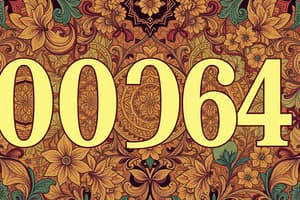Podcast
Questions and Answers
When converting a decimal number to base-r using the remainder method, what condition signifies the termination of the successive division?
When converting a decimal number to base-r using the remainder method, what condition signifies the termination of the successive division?
- When the remainder is 0
- When the quotient is 1
- When the quotient is 0 (correct)
- When the remainder is 1
When converting the fractional part of a decimal number to another base, successive division is used.
When converting the fractional part of a decimal number to another base, successive division is used.
False (B)
Using the remainder method, what is the first step in converting the integer part of a fixed-point number to a different base?
Using the remainder method, what is the first step in converting the integer part of a fixed-point number to a different base?
Separate the number into its integer and fractional parts.
In the remainder method, the new number in base 'r' is obtained by reading the remainders from the last remainder ______.
In the remainder method, the new number in base 'r' is obtained by reading the remainders from the last remainder ______.
How is the fractional part of a decimal number converted to another base?
How is the fractional part of a decimal number converted to another base?
Which of the following best describes the foundation of digital logic?
Which of the following best describes the foundation of digital logic?
Digital logic design is primarily used for developing software applications.
Digital logic design is primarily used for developing software applications.
Name three basic digital logic gate functions.
Name three basic digital logic gate functions.
In digital computers, data is stored in terms of ______.
In digital computers, data is stored in terms of ______.
Match the following terms with their descriptions:
Match the following terms with their descriptions:
Why is the decimal system not convenient for machines at their fundamental level?
Why is the decimal system not convenient for machines at their fundamental level?
Which fields are most closely associated with digital logic design?
Which fields are most closely associated with digital logic design?
Digital logic designers only focus on the electrical characteristics of electronic components.
Digital logic designers only focus on the electrical characteristics of electronic components.
When using the nines' complement method for subtraction with decimal numbers, what adjustment is made after finding the sum of the first number and the nines' complement of the second number?
When using the nines' complement method for subtraction with decimal numbers, what adjustment is made after finding the sum of the first number and the nines' complement of the second number?
In binary subtraction using the method of complements, the ones' complement is obtained by inverting each bit, and the two's complement is then found by simply adding '1' to the ones' complement.
In binary subtraction using the method of complements, the ones' complement is obtained by inverting each bit, and the two's complement is then found by simply adding '1' to the ones' complement.
In the context of signed fixed-point numbers, what is the purpose of 'excess notation'?
In the context of signed fixed-point numbers, what is the purpose of 'excess notation'?
In signed magnitude representation, the __________ bit indicates the sign of the number.
In signed magnitude representation, the __________ bit indicates the sign of the number.
Match the following number representations with their corresponding characteristics:
Match the following number representations with their corresponding characteristics:
What is the primary advantage of using the method of complements in binary arithmetic?
What is the primary advantage of using the method of complements in binary arithmetic?
In an eight-bit signed magnitude representation, the number -12 would be represented as 10001100.
In an eight-bit signed magnitude representation, the number -12 would be represented as 10001100.
Why is dropping the '1' significant when performing subtraction using complements?
Why is dropping the '1' significant when performing subtraction using complements?
What is the result of performing a one's complement operation on the binary number 10101010?
What is the result of performing a one's complement operation on the binary number 10101010?
In one's complement representation, the leftmost bit being 1 indicates a negative number.
In one's complement representation, the leftmost bit being 1 indicates a negative number.
What is a primary disadvantage of using one's complement representation for numbers?
What is a primary disadvantage of using one's complement representation for numbers?
To form the two's complement of a number, you first complement all the bits and then add ______.
To form the two's complement of a number, you first complement all the bits and then add ______.
Which of the following is a key advantage of two's complement representation over one's complement?
Which of the following is a key advantage of two's complement representation over one's complement?
In two's complement representation, discarding the carry-out from the most significant bit during addition is always an error.
In two's complement representation, discarding the carry-out from the most significant bit during addition is always an error.
If you have an 8-bit number in two's complement representation, how many different numbers can be represented?
If you have an 8-bit number in two's complement representation, how many different numbers can be represented?
Match the number representation with its characteristic:
Match the number representation with its characteristic:
Which of the following statements accurately describes the behavior of an OR gate?
Which of the following statements accurately describes the behavior of an OR gate?
A NOT gate, or inverter, can have multiple inputs and a single output.
A NOT gate, or inverter, can have multiple inputs and a single output.
In a logical diagram of an inverter, what symbol indicates the logical inversion?
In a logical diagram of an inverter, what symbol indicates the logical inversion?
A NAND gate is equivalent to an AND gate followed by a(n) ______.
A NAND gate is equivalent to an AND gate followed by a(n) ______.
Match the logic gate with its corresponding function:
Match the logic gate with its corresponding function:
Given inputs x=1 and y=0, what is the output z of a NOR gate?
Given inputs x=1 and y=0, what is the output z of a NOR gate?
The triangle symbol in a digital inverter represents the logical inversion.
The triangle symbol in a digital inverter represents the logical inversion.
Write the boolean expression equivalent to: "The output is high if the light switch is ON or if the motion detector senses movement."
Write the boolean expression equivalent to: "The output is high if the light switch is ON or if the motion detector senses movement."
In binary logic, 1 + 1 always equals 10, similar to binary arithmetic.
In binary logic, 1 + 1 always equals 10, similar to binary arithmetic.
What are the three basic kinds of gates commonly used in digital logic design?
What are the three basic kinds of gates commonly used in digital logic design?
A standard 14-pin Integrated Circuit (IC) package can contain four 2-input gates, three 3-input gates, or two ______ gates.
A standard 14-pin Integrated Circuit (IC) package can contain four 2-input gates, three 3-input gates, or two ______ gates.
Match the gate type with its corresponding function.
Match the gate type with its corresponding function.
Flashcards
Digital Logic
Digital Logic
The foundation of electronic systems represented by binary code.
Binary Code
Binary Code
A system using two symbols, 0 and 1, to represent data.
Logic Gates
Logic Gates
Basic electronic components that perform logical operations.
Data Representation
Data Representation
Signup and view all the flashcards
Decimal System
Decimal System
Signup and view all the flashcards
Radix Number System
Radix Number System
Signup and view all the flashcards
Positional Calculation
Positional Calculation
Signup and view all the flashcards
Digital Logic Design
Digital Logic Design
Signup and view all the flashcards
Quotient Remainder Method
Quotient Remainder Method
Signup and view all the flashcards
Binary Conversion
Binary Conversion
Signup and view all the flashcards
Octal Conversion
Octal Conversion
Signup and view all the flashcards
Hexadecimal Conversion
Hexadecimal Conversion
Signup and view all the flashcards
Fractional Base Conversion
Fractional Base Conversion
Signup and view all the flashcards
NOT Operation
NOT Operation
Signup and view all the flashcards
AND Gate
AND Gate
Signup and view all the flashcards
Truth Table
Truth Table
Signup and view all the flashcards
OR Gate
OR Gate
Signup and view all the flashcards
Binary Logic Variable
Binary Logic Variable
Signup and view all the flashcards
Nines' Complement
Nines' Complement
Signup and view all the flashcards
Tens' Complement
Tens' Complement
Signup and view all the flashcards
Binary Ones' Complement
Binary Ones' Complement
Signup and view all the flashcards
Binary Two's Complement
Binary Two's Complement
Signup and view all the flashcards
Signed Magnitude Representation
Signed Magnitude Representation
Signup and view all the flashcards
Sign-Magnitude Example
Sign-Magnitude Example
Signup and view all the flashcards
Fixed Point Numbers
Fixed Point Numbers
Signup and view all the flashcards
Representation of Negative Numbers
Representation of Negative Numbers
Signup and view all the flashcards
One's Complement Representation
One's Complement Representation
Signup and view all the flashcards
Positive and Negative Zero
Positive and Negative Zero
Signup and view all the flashcards
Bit Complementing
Bit Complementing
Signup and view all the flashcards
Two's Complement Representation
Two's Complement Representation
Signup and view all the flashcards
Single Representation of Zero
Single Representation of Zero
Signup and view all the flashcards
Carry-Out Discarding
Carry-Out Discarding
Signup and view all the flashcards
Negative Representation Formation
Negative Representation Formation
Signup and view all the flashcards
Number Representation Limitations
Number Representation Limitations
Signup and view all the flashcards
OR Function
OR Function
Signup and view all the flashcards
Truth Table for OR
Truth Table for OR
Signup and view all the flashcards
Truth Table for NOT
Truth Table for NOT
Signup and view all the flashcards
Truth Table for NAND
Truth Table for NAND
Signup and view all the flashcards
Combined Gates
Combined Gates
Signup and view all the flashcards
Study Notes
Digital Logic Design
- A digital computer stores data in terms of digits (numbers) and proceeds in discrete steps from one state to the next. The states typically involve binary digits (0s and 1s).
- Digital Logic is fundamental to electronic systems (computers, cell phones).
- Binary code, a series of zeroes and ones, is used to design electronic circuits, including logic gates.
- Logic gates translate input signals into specific outputs, forming the base of computing and other applications.
- Digital Logic Design is key to building complex electronic components, encompassing electrical and computational characteristics.
- This design is used to develop hardware, such as circuit boards and microchip processors.
Data Representation and Number Systems
- Decimal is not suitable for machines as information is handled in terms of on/off bits.
- Radix (base) of a number system defines the range of values a digit can have.
- Binary (base 2): Two possible values (0 or 1) for each digit.
- Octal (base 8): Eight choices (0-7).
- Decimal (base 10): Ten different values (0-9).
- Hexadecimal (base 16): Sixteen values (0-9, A-F).
Conversion Among Radix
- Converting from Decimal to Any Base: Divide the decimal number repeatedly by the desired base, recording the remainders. The remainders, read from last to first, are the digits in the new base.
- Example: Converting 1234 (base 10) to binary.
Quotient Remainder Example
- Converting 1341 to binary by repeated division by 2
- Converting decimal numbers to other bases (binary, octal, hexadecimal) using the remainder method.
Other Notation Methods
- Binary (base 2) - Octal (base 8) - Hexadecimal (base16) conversions
- Polynomial method for conversion between bases and decimal.
Studying That Suits You
Use AI to generate personalized quizzes and flashcards to suit your learning preferences.




